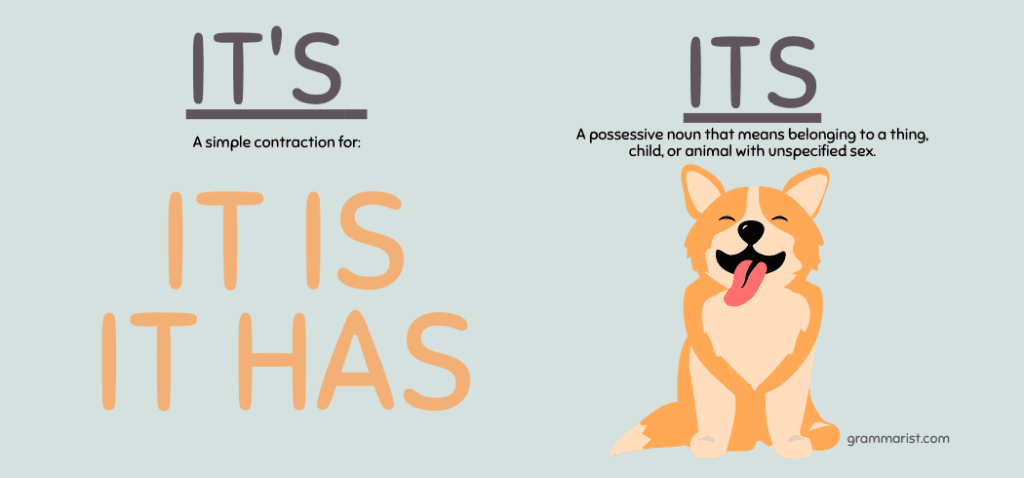Words and terms that sound the same but have different spellings and meanings can make us conscious of our writing. If you find it’s and its confusing, you’re not alone. I see people messing these up every day online, in my line of work, and even in published materials!
Keep reading to learn the difference between its and it’s. Understanding their definition and usage will help you be more confident in your writing and avoid this common mistake.
Difference Between “Its” and “It’s”

Its and it’s are homophones because of their similar sounds yet different definitions.
As an English grammar rule, Its is a possessive noun that means belonging to a thing, child, or animal with unspecified sex that is previously mentioned. Its usage in a sentence can be a determiner or a word that modifies the word before it, such as its importance.
It’s is a simple contraction for it is or it has. The definition of a contraction is a way to mash two words into one to make them shorter. Contractions are only recommended in casual or informal writing. If you are producing an academic text, try to keep the original words.
If you still find the two words confusing, try writing it has or it is instead. If the sentence makes sense, then it’s with the apostrophe is the correct word to use.
Does “Its” Always Need an Apostrophe?
It’s needs an apostrophe if you are referring to it has and it is contraction. But if you’re referring to the determiner, there should be no apostrophe. Mixing these conventions up is one of the most common and simple grammar mistakes people make.
How Do You Show Ownership With “Its”?
Its already shows ownership because it means belonging to a thing or object previously mentioned. It can also mean belonging to a child/animal of unspecified sex. Its counterparts include his, hers, theirs, yours, mine, and ours.
Can You Start a Sentence With “It’s”?
Yes, you can start a sentence with it’s where it is the subject.
Example:
- It’s a beautiful day to exercise, eat healthy meals, and catch up with friends.
“It’s Been” or “Its Been”?
The correct phrase is it’s been, which means it has been. Here, it’s is a contraction for it has instead of it is.
How to Use “Its” in a Sentence
Here are some examples of its in a sentence.
- Its nature should be examined so we can make better educational policies.
- Do you like cotton candy? Its ingredient is pure sugar.
- Its lyrics are catchy, but the tune is mediocre.
- The house needs its ceilings fixed.
- The shop is raising its prices because of inflation.
How to Use “It’s” in a Sentence
Here are some examples of it’s in a sentence.
- It’s so lovely to see you!
- I’ll make sure it’s going to be done today.
- Do you like cotton candy? It’s my favorite dessert.
- Ralph chose the program because it’s been his dream since he was eight.
- I think it’s in your pocket.
Final Word on “Its” vs. “It’s”
It’s okay if you confuse the usage of it’s and its. Even I do it from time to time. But it’s better to learn when to use its and it’s to keep your text clear and error-free.
My writing tips have shown you the definition and examples of its and it’s. Use its as a possessive form of it. And use it’s as a contraction for it is or it has.